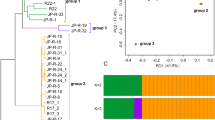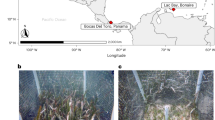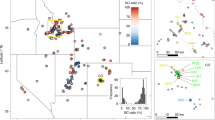Summary
The L. corniculatus populations at Porthdafarch are polymorphic for the characters of leaf cyanogenesis, petal cyanogenesis and keel petal colour. Plants with cyanogenic leaves and petals occur less frequently on the sea cliffs than inland and previous studies have obtained circumstantial evidence of a link between the cline in leaf cyanogenesis and the distribution of selectively grazing molluscs. Counts of leaf and petal damage have confirmed that plants on the cliffs are grazed less heavily than those growing inland and have demonstrated that individuals with acyanogenic leaves or petals are liable to be chewed more heavily than their cyanogenic neighbours. Most of the damage was attributable to feeding by molluscs and it is concluded that herbivorous insects have only a minor role in the maintenance of the clines.
Similar content being viewed by others
Article PDF
References
Bubar, J S, and Miri, R K. 1965. Inheritance of self-incompatibility and brown keel tip in Lotus corniculatus L. Nature, 205, 1035–1036.
Buzzell, R I, and Wilsie, C P. 1963. Genetic investigation of brown keel tip colour in Lotus corniculatus L. Crop Science, 3, 128–130.
Cates, R G. 1975. The interface between slugs and wild ginger: some evolutionary aspects. Ecology, 56, 391–400.
Compton, S G. 1983. Studies of insects associated with Lotus corniculatus L. Ph. D. Thesis, University of Hull.
Crawford-Sidebotham, T J. 1972. The role of slugs and snails in the maintenance of the cyanogenesis polymorphisms of Lotus corniculatus and Trifolium repens. Heredity, 28, 405–411.
Dirzo, R, and Harper, J L. 1982. Experimental studies on slug-plant interactions III. Differences in the acceptability of individual plants of Trifolium repens to slugs and snails. J Ecol, 70, 101–117.
Ellis, W M, Keymer, R J, and Jones, D A. 1977. On the polymorphism of cyanogenesis in Lotus corniculatus L. VIII. Ecological studies in Anglesey. Heredity, 39, 45–65.
Guérin, P. 1929. La teneur en acide cyanhydrique des Lotus. Cr Lebd Séanc Acad Sci, Paris, 187, 1011–1013.
Harper, J L. 1980. Plant demography and ecological theory. Oikos, 35, 244–253.
Jones, D A. 1962. Selective eating of the acyanogenic form of the plant Lotus corniculatus L. by various animals. Nature, 193, 1109–1110.
Jones, D A. 1963. Polymorphisms and Antibodies in lower organisms. D. Phil. Thesis, University of Oxford.
Jones, D A. 1966. On the polymorphism of cyanogenesis in Lotus corniculatus. Selection by animals. Can J Genet Cytol, 8, 556–567.
Jones, D A. 1972. Cyanogenic Glycosides and their Function. In Harborne J. B. (ed.) Phytochemical Ecology, Academic Press, London, pp 103–124.
Jones, D A. 1977. On the polymorphism of cyanogenesis in Lotus corniculatus L. VII. The distribution of the cyanogenic form in Western Europe. Heredity, 39, 27–44.
Jones, D A, and Crawford, T J. 1977. Variation in the colour of the keel petals in Lotus corniculatus L. I. The polymorphism in Western Europe. Heredity, 39, 313–325.
Keymer, R J. 1978. Genecological studies of cyanogenesis in Lotus corniculatus (L.). Ph.D. Thesis, University of Hull.
Keymer, R J, and Ellis, W M. 1978. Experimental studies on plants of Lotus corniculatus L. from Anglesey polymorphic for cyanogenesis. Heredity, 40, 189–206.
Malan, M A. 1973. Preliminary studies of the ecology of the heath snail Helicella itala (L.). M.Sc. Thesis, University College of North Wales, Bangor.
McKey, D. 1979. The distribution of secondary compounds within plants. In Rosenthal, G. A. and Janzen, D. H. (eds.). Herbivores: their interaction with secondary plant metabolites. Academic Press, London pp 55–133.
Parsons, J, and Rothschild, M. 1964. Rhodanese in the larvae and pupae of the common blue butterfly (Polyommatus icarus Rott., Lepidoptera). Ent Gaz, 15, 58–59.
Ramnani, A D. 1979. Studies on cyanogenesis and the colour of the keel petals of Lotus corniculatus (L.). Ph.D. Thesis, University of Hull.
Author information
Authors and Affiliations
Rights and permissions
About this article
Cite this article
Compton, S., Beesley, S. & Jones, D. On the polymorphism of cyanogenesis in Lotus corniculatus L. IX. Selective herbivory in natural populations at Porthdafarch, Anglesey. Heredity 51, 537–548 (1983). https://doi.org/10.1038/hdy.1983.69
Received:
Issue date:
DOI: https://doi.org/10.1038/hdy.1983.69
This article is cited by
-
Variation in the colour of the keel petals in Lotus corniculatus L. 5. Successional differences in the distribution of dark-keeled plants
Heredity (1988)
-
Differential grazing by the mollusc Arion hortensis Fér. on cyanogenic and acyanogenic seedlings of the white clover, Trifolium repens L.
Heredity (1986)
-
Variation in the colour of the keel petals in Lotus corniculatus L. 3. Pollination, herbivory and seed production
Heredity (1986)



